Research Problem - Research Aptitude Notes
How to find the research problem
- A research involves a methodical process that emphasizes objectivity and the collection of a variety of information for analysis, enabling the researcher to draw conclusions.To find a good research problem, we must have to consider five factors to check whether the problem is researchable or not.
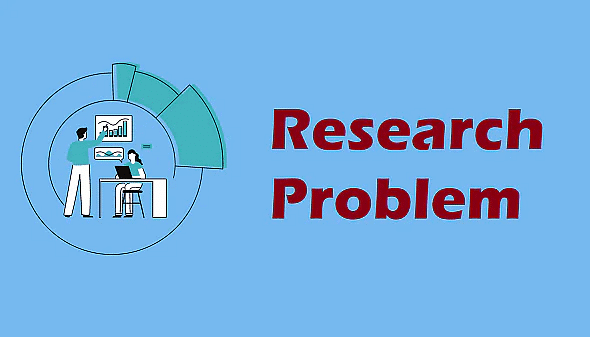
The five factors are as follows.
- All the existing problem in country or in the world, which don’t have any known solution.
- Whether the solution can be obtained by using the statistical tools and techniques
- There are lots of solutions available, but they are not yet tested physically
- To conclude a solution, problem need scientific investigation.
- Emergency needs or problems of the mankind where it demands research
Characteristics of any research problem
Not all the problem arises in universe a research problem. A research problem must have some characteristics. Following are the characteristics of a research problem. If any problem posses all these properties, then it is said to be a research problem. - Specific: The problem must be specifically tested
- Measurable: The problem is easy to measure by using some research tool or equipment
- Achievable: The data needs to do the research must be achievable using correct tools to get the final result
- Realistic: The final result must be realistic and must reflect in the real world
- Time bound: In all the activities of the research, there must be time bound because if the time span to complete an activity is smaller then it is obviously better
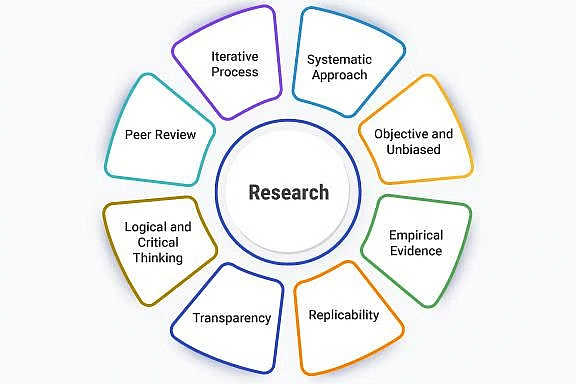
Sources of research problem
Though it is true that there are lots of research problem available in our world, but sometimes students failed to find a good research problem. Finding out the research problem is a big task for a researcher specifically, student. Following are important points, which must kept in mind to find out a research problem. - Specialization of the researched one have to take care about the specialization of the student)
- what are the current scenarios in research and what have been done in past on that topic
- One can take recommendation from previous theses or research reports.
- Look after all the problems in the locality or in nation.
Criteria of a good research problem
Some research problem is said to be good, some are moderate and others not at all fits in current scenario. The research problem is said to be good if it has the following properties. - Interesting: research problem must be interested such that it attracts the students.
- Innovative: problem must be innovative, so that students can apply innovative idea in that problem to get the result.
- Cost-effective: a good research problem must be economical
- Relevancy: Research problem must be relevant to the needs of people
- Research problem must be relevant to the government, nation, and mankind.
- Timeliness: An unbounded research problem is not feasible. There must be time bound in a good research problem.
Hypothesis
A proposition that can be verified to determine its reality is a hypothesis. A hypothesis may be defined as a logically conjectured relationship between two or more variables, expressed in the form of a testable statement. Relationship is proposed by using a strong logical argumentation. This logical relationship may be part of theoretical framework of the study.For example,
- Officers in my organization have higher than average level of commitment (variable).
- Level of job commitment of the officers is associated with their level of efficiency.
- Level of job commitment of the officers is positively associated with their level of efficiency.
- The higher the level of job commitment of the officers the lower their level of absenteeism.
There are different types of hypothesis which are as follows
- Descriptive Hypothesis
- Relational Hypothesis
- Correlational hypotheses
- Explanatory (causal) hypotheses
- Null Hypothesis
- Alternative Hypothesis
- Research Hypothesis
Descriptive Hypothesis: Descriptive hypothesis contains only one variable thereby it is also called as univariate hypothesis. Descriptive hypotheses typically state the existence, size, form, or distribution of some variable.
Steps of Research
- Formulating the Research Problem
- Reviewing the Research Structure
- Conducting the Literature Review
- Developing the Hypothesis
- Preparation of Research Design
- Sampling
- Collection of Data
- Analysis and Interpretation of Data
- Concluding the Data and Formal Write-up of the Research Report
The steps can be explained as follows:
Formulating the Research Problem
- Problem: The initial stage in research formulation involves clearly defining a research problem. There isn't a foolproof method for this, but certain working conditions can aid researchers in this process.
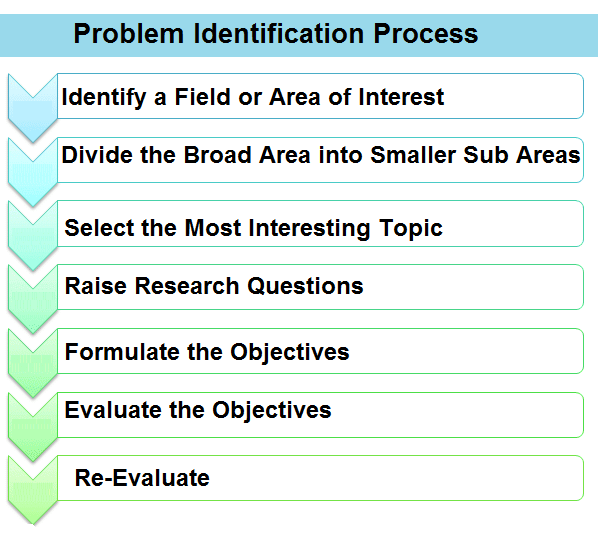
- Stages of Formulating a Research Problem:
- Selection of a Research Area: Researchers begin by choosing a broad research topic based on personal experience, literature, previous research, and theories of interest.
- Dissecting the Research Area: If the chosen subject area is broad, researchers should break it down into smaller sub-areas or topics. For instance, if the topic is 'childhood nutrition,' it can be further divided into childhood development, malnutrition in children, child immunization, childhood diseases, childhood mortality, and childhood vaccines.
- Focus on Selecting an Area of Interest: Researchers then narrow down their focus to one or two areas of personal interest, disregarding sub-areas that do not align with their interests.
- Generating Research Questions: Researchers should create numerous research questions related to the selected area or topic. These questions must be structured to be answerable using scientific techniques and research procedures.
- Deciding on Objectives: Objectives serve as potential answers to the research questions formulated. They provide specificity to the study, guiding it around the predetermined objectives, which can be specific or general in nature.
- Formulating the Final Statement of the Research Problem: After establishing the significance, researchability, and feasibility of the topic, researchers craft a conclusive statement of the research problem. This problem statement can be in declarative or interrogative form.
Reviewing the Research Structure
- After formulating the research problem, the researcher needs to review the research structure.
- This step provides essential background knowledge about the problem area.
- Reviewing the structure also informs the researcher about previous studies conducted in the field, the methodologies used in those studies, and the conclusions drawn regarding the problem area.
Conducting the Literature Review
- The literature review is often the longest phase in the research process. In fact, it begins even before formulating the research aims and objectives because it is essential to check if the exact same research problem has been addressed previously. However, the core part of the literature review is conducted after the research aims and objectives have been established.
- During this phase, it is crucial to utilize a wide range of secondary data sources, including books, newspapers, magazines, journals, and online articles.
The purpose of the literature review includes the following:
- Defining Research Limits: The review of related literature helps researchers define the boundaries of their field.
- Problem Delimitation: It assists researchers in narrowing down and defining their research problem.
- Avoiding Redundancy: By reviewing related literature, researchers can steer clear of unproductive and irrelevant problem areas. It also helps prevent unintentional duplication of well-established findings.
- Understanding Research Methodology: The literature review provides insights into various research methodologies employed in previous studies.
- Informed Recommendations: Reviewing literature allows researchers to be aware of the recommendations made by previous researchers for further exploration in their studies.
 |
Download the notes
Steps of Research - Research Problem & Structure
|
Download as PDF |
Identifying Variables and Formulating Hypotheses in Research
When conducting research, the next crucial step involves identifying the variables and formulating a hypothesis. Let's break down these concepts for better understanding.
Variables in Research:
- Variables are the measurable traits or factors that can change throughout the course of an experiment or study. They are central to the research process. A variable is defined as anything that can vary or change in value. For example, a person's attitude towards women empowerment is a variable because it can range from highly favorable to highly unfavorable.
- Variables can take two or more values because they represent qualities that can exhibit differences in value, usually in terms of magnitude or strength. For instance, the level of education a person has is a variable because it can vary from no education to a doctorate degree.
Selection of Variables:
When selecting variables for a study, researchers need to be careful and consider several factors:
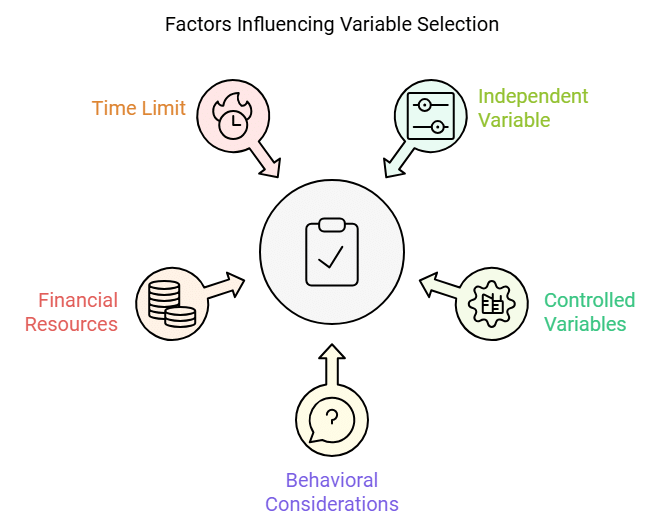
- Independent Variable: This is the variable that the researcher intends to manipulate or change. It is important to clearly identify which variable will be the focus of manipulation.
- Controlled Variables: These are variables that need to be kept constant to ensure that any changes observed in the dependent variable are solely due to the manipulation of the independent variable. Researchers should consider how they will control these variables when selecting them.
- Behavioral Considerations: Researchers should keep in mind behavioral aspects when selecting variables. The variables should not be too numerous, as this can complicate the research process.
- Financial Resources: The selection of independent and dependent variables should also take into account the financial resources available for the study. Researchers should be mindful of the costs involved in measuring and manipulating the chosen variables.
- Time Limit: Researchers should consider the time constraints when selecting variables. It is important to choose variables that can be effectively studied within the available time frame.
Formulating Hypotheses
- A hypothesis is a testable prediction about the relationship between variables. It is an educated guess that researchers make based on their understanding of the topic. When formulating a hypothesis, researchers need to clearly state the expected relationship between the independent and dependent variables.
- For example, if a researcher is studying the impact of sleep on academic performance, the hypothesis could be: "Increased hours of sleep (independent variable) will lead to higher academic performance (dependent variable) among students."
In summary, identifying variables and formulating hypotheses are crucial steps in the research process. Researchers must carefully select variables based on various considerations and clearly state their predictions about the relationships between these variables to guide their study effectively.
Types of Variables
(i) Independent Variable: This is the variable that the researcher manipulates during an experiment. It is the variable that influences or affects another variable within the system.
(ii) Dependent Variable: This variable changes as a result of modifications made to the independent variable. Unlike the independent variable, it does not influence or affect any other variable within the system.
(iii) Intervening Variable: This is a hypothetical variable used to explain the causal relationships between other variables. Intervening variables serve as intermediaries through which one variable impacts another.
(iv) Extraneous Variable: These variables affect the dependent variable but are not part of the primary system being studied. There can be multiple extraneous variables that may influence the outcome of the experiment.
(v) Continuous Variable: Continuous variables can take on an infinite number of values between any two points. They are numeric variables expressed continuously. Examples include the length of a part, date, and time of payment receipt.
(vi) Discrete or Non-Continuous Variable: These are numeric values with a countable number of values between any two points. An example is the number of customer complaints.
(vii) Categorical Variable: Categorical variables consist of a finite number of categories or distinct groups. Categorical data may not have a logical order. For instance, categorical predictors include gender.
(viii) Active Variable: An active variable is one that can be manipulated in an experiment. Active variables are also referred to as experimental variables.
(ix) Attribute Variable: An attribute variable is one that cannot be manipulated. These variables are inherent to a person or object and cannot be altered by the researcher.
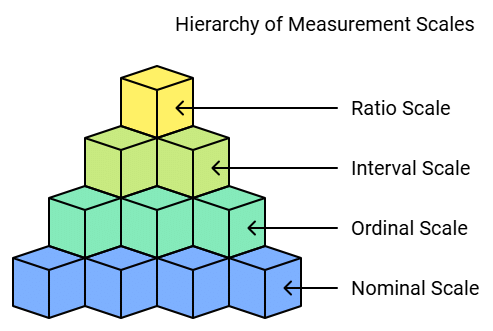
Measuring Variables:
The measurement of variables is a fundamental aspect of research studies. Various scales are employed to measure these variables, each serving a specific purpose. Let's explore these scales in detail:
Nominal Scale:
- The nominal scale is used to classify individuals, objects, or responses into sub-groups based on a common or shared characteristic. This scale allows for the categorization of variables into one, two, or more sub-categories depending on the degree of variation.
Ordinal Scale:
- The ordinal scale is the most basic form of an ordered scale. It is used to rank variables in a specific order. For instance, when assessing customer satisfaction with a service, respondents may express their satisfaction levels as very satisfied, satisfied, neutral, dissatisfied, or very dissatisfied. This scale enables both categorization and ranking of responses.
Interval Scale:
- The interval scale is employed for variables that can be categorized, ranked, and expressed in increments. This scale features an arbitrary zero point, with numbers placed at equal intervals. It is commonly used in attitude measurement and examples include temperature measurements. The interval scale allows for the calculation of averages such as mean, median, and mode, as well as measures of dispersion like range and standard deviation.
Ratio Scale:
- The ratio scale represents the highest level of measurement. It enables researchers to compare both differences in scores and the relative magnitudes of scores. Examples of ratio scale measurements include weight, length, and time. This scale has an absolute zero point and is used to calculate all scientific variables. Without the ratio scale, scientific variables cannot be accurately measured.
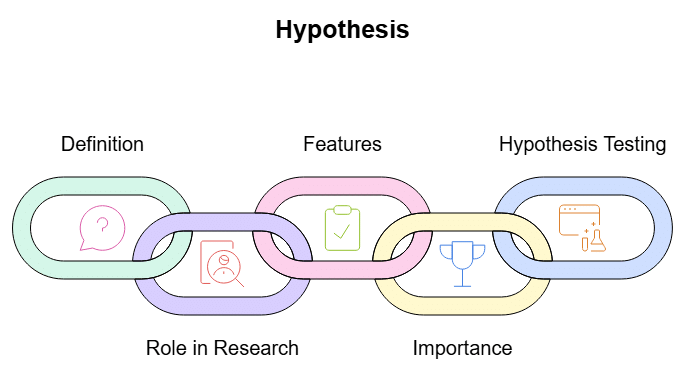
Developing Hypothesis
- The term "hypothesis" is derived from two words: "hypo" and "thesis." "Hypo" signifies something tentative or subject to verification, while "thesis" refers to a statement about potential solutions to a problem. Therefore, a hypothesis can be understood as a tentative explanation or a possible outcome related to a research problem.
- According to Good and Hatt, a hypothesis is a proposition that can be tested to determine its validity. Similarly, Kerlinger defines a hypothesis as a conjectural statement regarding the relationship between two or more variables.
- A hypothesis plays a crucial role in the research process by enabling the attainment of reliable knowledge. It represents a presumptive statement or an educated guess based on existing evidence, which the researcher aims to validate through their study. Formulating a hypothesis involves proposing a potential solution to a problem, with the expectation that the subsequent research will either support or refute it.
Features of a Hypothesis:
- Clarity and Precision: The hypothesis should be stated clearly and precisely, leaving no room for ambiguity.
- Testability: It must be possible to test the hypothesis through empirical investigation.
- Expected Relationship: The hypothesis should specify the expected relationship between the variables involved.
- Sscope: The hypothesis should be limited in scope, focusing on a specific aspect of the research problem.
- Consistency with Facts: It should be consistent with most known facts and existing knowledge.
- Simplicity: The hypothesis should be stated in simple terms, making it easily understandable.
Importance of a Hypothesis:
- Scientific Validity: The hypothesis ensures that the entire research methodology is scientific and valid.
- Research Monitoring: It helps in assessing the likelihood of research failure or progress.
- Theoretical Link: The hypothesis provides a link between the underlying theory and the specific research question.
- Data Analysis: It aids in data analysis and measures the validity and reliability of the research.
- Evidence Basis: The hypothesis provides a basis or evidence to prove the validity of the research.
- Concrete Descriptions: It helps in describing the research study in concrete terms rather than abstract theoretical terms.
Types of Hypothesis
Null Hypothesis:
- The null hypothesis, often referred to as the "zero hypothesis," is a type of hypothesis that a researcher develops without any specific input or influence. It suggests that there is no statistically significant difference or effect in a given set of observations.
Directional and Non-Directional Hypotheses:
- A directional hypothesis specifies the direction of the expected difference or relationship between variables. It is more precise about the expected outcomes.
- In contrast, a non-directional hypothesis indicates only that there will be a difference or relationship between variables, without specifying the direction.
Declarative Hypothesis:
- A declarative hypothesis is formulated as a declarative statement, expressing a relationship between variables. It represents a positive assertion about the study's outcome.
Complex Hypothesis:
- A complex hypothesis involves the relationship between multiple dependent and independent variables. For example, consuming more fruits and vegetables may lead to weight loss, improved skin, and reduced disease risk.
Statistical Hypothesis:
- A statistical hypothesis, also known as confirmatory data analysis, is an assumption about a population parameter.
Descriptive Hypothesis:
- A descriptive hypothesis describes the existence, size, form, or distribution of a variable. It prompts researchers to consider the implications of their findings.
Relational Hypothesis:
- A relational hypothesis explores the relationship between two variables in a specific context. It can be correlational or explanatory.
- (a) Correlational Hypothesis: This type of hypothesis indicates that variables occur together in a specified manner without implying causation.
- (b) Explanatory Hypothesis: This hypothesis describes a relationship where one variable causes a specific effect on another variable.
Alternative Hypothesis:
- An alternative hypothesis is the opposite of the null hypothesis, suggesting a statistical significance or relationship between variables. The researcher aims to demonstrate a connection between the variables.
Understanding Hypothesis Testing
Hypothesis testing, also known as significance testing, is a statistical method used to evaluate a claim or hypothesis about a population parameter based on data collected from a sample. The primary goal of hypothesis testing is to assist researchers in drawing conclusions about a population by analyzing a representative sample. This process helps determine whether the available data supports or refutes the proposed hypothesis.
Steps in Hypothesis Testing
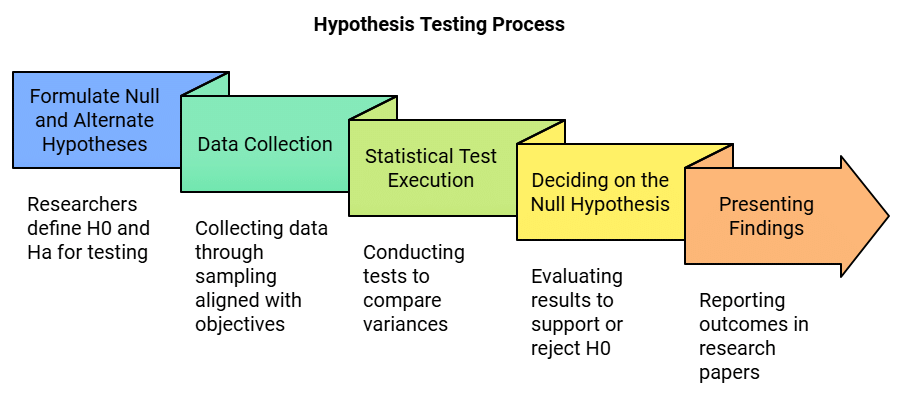
- Formulate Null and Alternate Hypotheses: After developing an initial research hypothesis, it is crucial to reframe it as a null (H0) and an alternate (Ha) hypothesis for testing. The alternate hypothesis typically reflects the initial hypothesis suggesting a relationship between variables, while the null hypothesis posits no relationship between the variables of interest.
- Data Collection: To ensure the validity of a statistical test, data collection through sampling must be designed to effectively test the hypothesis. The method of sampling and data collection should be aligned with the research objectives.
- Statistical Test Execution: Various statistical tests are available, each focusing on comparing within-group variance (the spread of data within a category) to between-group variance (the differences between categories). The choice of statistical test depends on the nature of the data and the hypothesis being tested.
- Deciding on the Null Hypothesis: Based on the results of the statistical test, researchers must decide whether to support or reject the null hypothesis. Typically, a significance level of 0.05 is used as a threshold for rejection, indicating less than a 5% probability of observing the results if the null hypothesis were true.
- 5. Presenting Findings: The outcomes of hypothesis testing are reported in the results and discussion sections of research papers. The results section provides a summary of the data and the statistical test results, while the discussion section focuses on whether the initial hypothesis was supported or refuted based on the findings.
Errors in Hypothesis Testing
There are four possible scenarios in hypothesis testing:
- Type I Error: This occurs when a true null hypothesis is incorrectly rejected. In other words, it is concluded that there is an effect or difference when, in reality, there is none. This is often referred to as a "false positive."
- Correct Decision: If the null hypothesis is true and is not rejected, this is a correct decision. It means that the data did not provide enough evidence to support an alternative hypothesis.
- Correct Decision (Alternative Hypothesis): When the null hypothesis is false and is correctly rejected, it indicates that the alternative hypothesis is supported by the data. This is a desired outcome in hypothesis testing, as it means the research question has been answered positively.
- Type II Error: This occurs when a false null hypothesis is not rejected. In this case, it is concluded that there is no effect or difference when, in fact, there is one. This is known as a "false negative."
Generalization and Interpretation: If a hypothesis is consistently supported by data, it can be generalized and used for formulating theories. This process helps in applying research findings to real-life problems. On the other hand, if a researcher starts without a hypothesis, they may explain their findings based on existing theories. This process of interpretation can lead to new questions and further research.
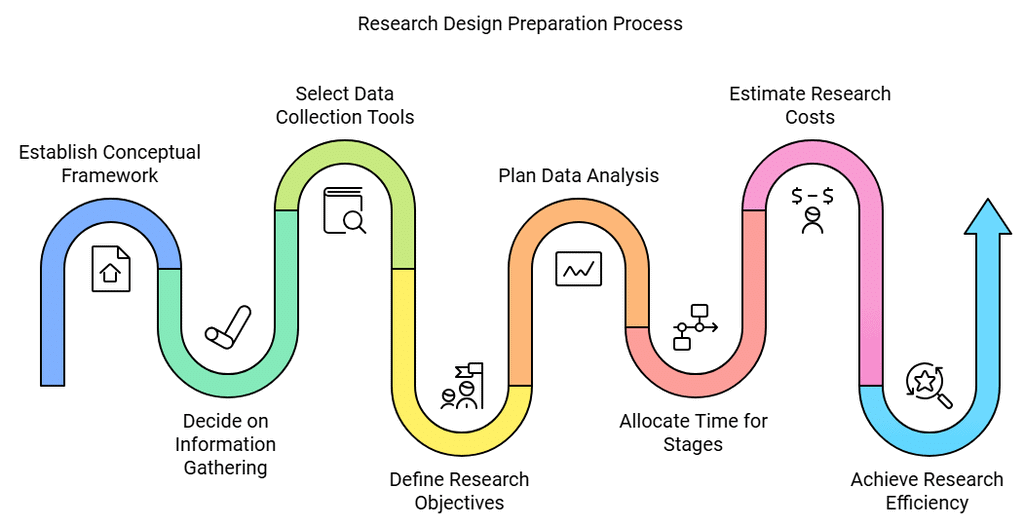
Preparation of Research Design
Research design, as defined by Russel Ackoff, is the process of making decisions before a situation arises where those decisions need to be implemented. In this step, the researcher establishes the conceptual framework within which the research will be conducted. Several important aspects must be considered when preparing a research design:
- Means of obtaining information: Deciding how the information will be gathered.
- Tools of data collection: Selecting the instruments or methods for collecting data.
- Objectives of the research study: Clearly defining what the research aims to achieve.
- Data analysis: Planning how the collected data will be analyzed, both qualitatively and quantitatively.
- Time available for each stage of the research: Allocating time for different phases of the research process.
- Cost involved for the research: Estimating the financial resources required for the research.
This step helps researchers determine the course of action during various stages of the research, saving time and resources.
Objectives of Research Design
Research design serves several important objectives:
- Efficiency: It makes research more efficient by optimizing resource utilization.
- Reliability and Flexibility: It ensures the reliability of results and allows flexibility in the research process.
- Systematic Arrangement: It helps arrange research systematically, providing clear direction.
- Problem-Solving: It aids in finding solutions to research problems and questions.
Types of Research Designs
Research designs vary based on the nature of the problem and the objectives of the study. One common type is:
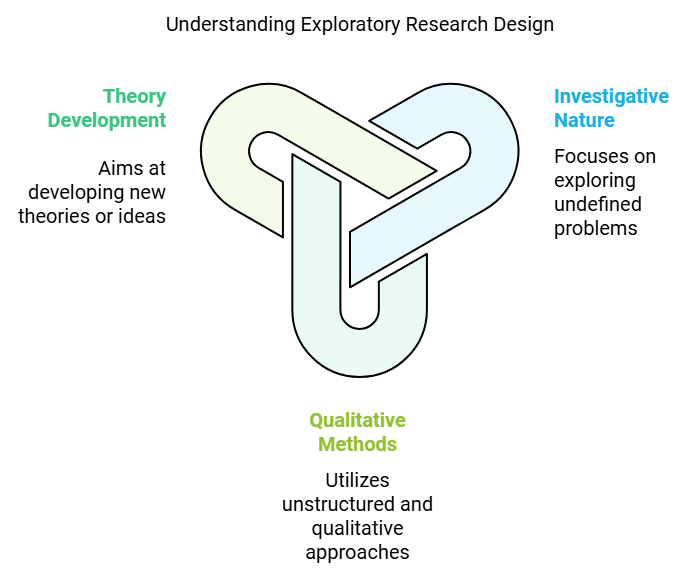
Exploratory Research Design:
- Exploratory research is a type of research design that seeks to investigate research questions without providing definitive answers to existing problems. It is also known as "formulative research design."
- This form of research is typically employed when studying a problem that has not yet been clearly defined. The primary objective of exploratory research is the development of theories or new ideas by formulating a research problem for in-depth analysis or by establishing a working hypothesis. Qualitative and unstructured research methods are commonly used in this type of research.
Conclusive Research Design:
- Conclusive research design is aimed at assisting decision-makers in evaluating and selecting the best course of action in a given situation. Unlike exploratory research, conclusive research is formal and structured. The data collected in this type of research is subject to quantitative analysis.
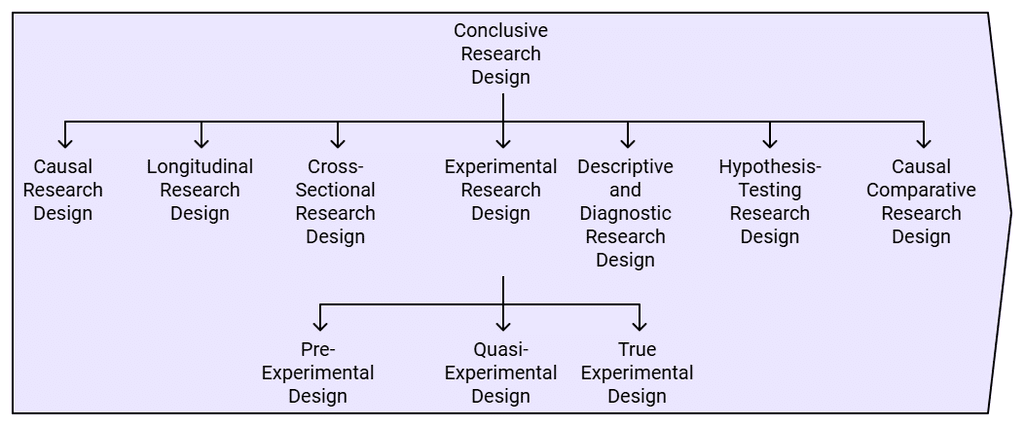
Various types of conclusive research design include:
- Causal Research Design: This design explores cause-and-effect relationships between variables.
- Longitudinal Research Design: This involves collecting data over an extended period to observe changes over time.
- Cross-Sectional Research Design: This design collects data at a single point in time to analyze a snapshot of a population.
Experimental Research Design: Experimental research design involves conducting research with a scientific approach, where certain variables are kept constant while others are manipulated and measured. The primary goal is to observe the effect of independent variables on dependent variables under controlled conditions. Experimental research can be categorized into:
- Pre-Experimental Design: A basic form of experimental design that lacks randomization.
- Quasi-Experimental Design: This design involves manipulation of variables without random assignment.
- True Experimental Design: A rigorous design that includes random assignment of subjects to groups.
Descriptive and Diagnostic Research Design:
- Descriptive research design focuses on describing the characteristics of a specific individual or group. It aims to provide a detailed account of the subject being studied. On the other hand, diagnostic research aims to determine the frequency of occurrence of a variable or its relationship with another variable.
- In simpler terms, descriptive research narrates facts and characteristics related to an individual, group, or situation, while diagnostic research analyzes whether a certain variable is associated with another variable.
Hypothesis-Testing Research Design:
- In hypothesis-testing research design, the researcher tests the hypothesis regarding the causal relationship between two or more variables. This type of research requires a procedure that minimizes biases, enhances reliability, and facilitates drawing inferences about causality.
- Experiments are commonly used in this type of research design. Therefore, when discussing research design in such studies, it often refers to the design of experiments.
Cross-Sectional Research Design:
- Cross-sectional research design involves collecting data on multiple cases simultaneously, or at the same point in time. This design is used to gather quantitative and quantifiable data with two or more variables, which are then analyzed to identify patterns of connectivity.
- Researchers who employ cross-sectional design are interested in variation or differentiation. In this type of research design, a sample is surveyed, and the survey is repeated on at least one more occasion.
Causal Comparative Research Design:
- Causal comparative research design aims to find relationships between independent and dependent variables after an action or event has already occurred. It seeks to determine the causes or consequences of differences that exist between or among groups of individuals.
- This design is less time-consuming and economical. It allows the researcher to analyze based on personal opinions and arrive at the best possible solutions. In causal comparative research, the independent variable cannot be manipulated.
Longitudinal Research Design:
- Longitudinal research design is characterized by its high time and cost demands. It is less commonly used in social research compared to other designs. Longitudinal research can be seen as an extension of survey research, involving self-completion questionnaires or structured interviews within the context of cross-sectional research design.
- Longitudinal research involves observational studies, where researchers record information about their subjects without manipulating the study environment. This design allows researchers to detect developments or changes in the characteristics of the target population at both the group and individual levels.
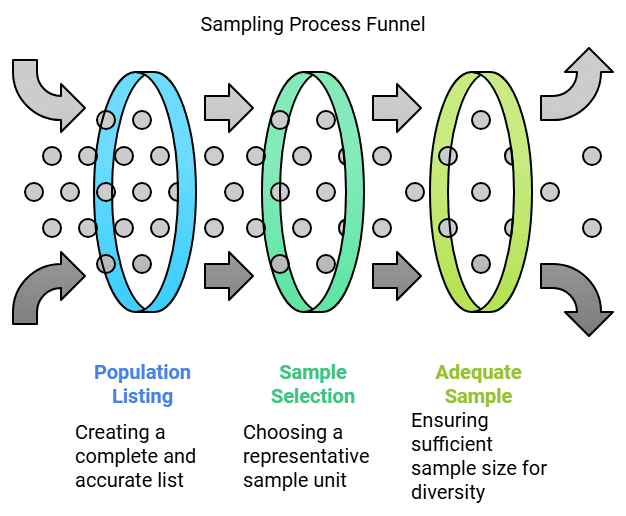
Sampling
Sampling involves selecting a small group of individuals, objects, or events to learn about a larger population from which they are drawn. The process typically includes four key steps:
(i) Defining the Population:
- A population refers to a specific group of living beings or non-human entities, such as educational institutions or geographical areas. Clearly defining the population is crucial; otherwise, the researcher may struggle to determine which units to include when selecting the sample.
(ii) Listing the Population:
- To select a sample from a given population, it is essential to have a complete, accurate, and up-to-date list of all units within the population. This ensures that the sample can be chosen from all available units.
(iii) Selecting a Representative Sample:
After defining the population and listing all units, the researcher selects a sample unit from the sampling frame. This step is critical to ensure that the sample accurately represents the population.(iv) Obtaining an Adequate Sample:
- If the population is homogenous, a small sample may suffice. However, if there is significant variability among the population units, a larger sample will be necessary to capture that diversity.
Types of Sampling
The method of selecting a sample is crucial and depends on the nature of the data and the investigation. Sampling techniques can be classified into:
Non-probability Sampling: Non-probability sampling does not involve estimating the probability of each item in the population being included in the sample. In this approach, items are selected at the researcher’s discretion. Non-probability sampling is cost-effective, time-efficient, and easy to use, especially when probability sampling is impractical (e.g., with a very small population). However, it does not allow for the calculation of confidence intervals and margins of error, which is why probability sampling is often preferred.
The types of non-probability sampling include:
(a) Judgement Sampling: The researcher uses their judgement to select population members who are likely to provide accurate information. This method is suitable for historical or descriptive research.
(b) Quota Sampling: Interviewers are given quotas to fill from different strata, with some restrictions on how these quotas are to be filled. Quota sampling is convenient and relatively inexpensive.
(c) Haphazard Sampling: The researcher chooses items haphazardly, attempting to simulate randomness. However, this method may introduce selection bias and the results may not be truly random.
Snowball Sampling: Snowball sampling is a non-probability technique used by researchers to identify potential subjects in studies where participants are difficult to locate. This method is particularly useful for studying small informal social groups and their impact on formal organizational structures.
In snowball sampling, initial respondents are contacted and asked to provide additional contacts who may also be relevant to the study. This process continues, creating a "snowball" effect as more participants are added to the sample.
There are different types of snowball sampling, including:
- Linear Snowball Sampling: Each participant refers one other participant.
- Exponential Snowball Sampling: Each participant can refer multiple others, leading to rapid growth in the sample size.
- Non-discriminative Snowball Sampling: Participants are chosen without specific criteria.
- Exponential Discriminative Snowball Sampling: Participants are selected based on certain criteria, but referrals can still be multiple.
Probability Sampling: Probability sampling, also known as random sampling or chance sampling, is a method where every item in the universe has an equal chance of being included in the sample. This approach allows researchers to determine the sample size needed for a desired level of accuracy and estimate the error magnitude due to sampling. Different methods of probability sampling include:
(a) Simple or Restricted Random Sampling:
- In this method, each unit of the population has an equal chance of being selected for the sample.
(b) Stratified Random Sampling:
- Stratified random sampling involves dividing the population into sub-populations (strata) that are more homogeneous than the total population. Items are then selected from each stratum to constitute the sample.
(c) Cluster Sampling:
- Cluster sampling involves dividing the total population into small sub-divisions (clusters), which are themselves clusters of smaller units. Some of these clusters are randomly selected for inclusion in the overall sample.
(d) Multi-Stage Sampling:
- This method is used in large-scale surveys for comprehensive investigations. Researchers may use two, three, or four stages of sampling to select participants.
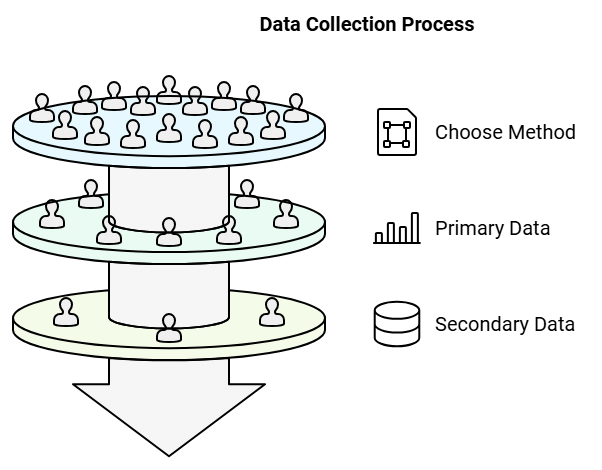
Collection of Data
The next phase in the research process involves the collection of data. There are various methods available for gathering relevant data. The researcher must choose a method based on the nature of the investigation, the scope and objectives of the inquiry, financial costs, time availability, and the desired level of accuracy. Data can be classified as primary or secondary depending on its source.
Primary Data:
Primary data is collected by the researcher specifically to meet the requirements of the study. This data is gathered through methods such as observation, interviews, questionnaires, and schedules. These methods are discussed below:
(a) Observation Method: The observation method is commonly used, especially in studies related to behavioral sciences. In this method, information is gathered through the researcher's direct observation without asking respondents.
(b) Interview Method: The interview method can be conducted through personal interviews or telephone interviews.
- Personal Interview: In a personal interview, the investigator follows a structured approach with pre-conceived questions. The success of this method depends significantly on the interviewer's ability. The interview should be friendly, courteous, conversational, and unbiased.
- Telephone Interview: This method involves contacting respondents via telephone. While not widely used, it is effective when surveys need to be completed quickly.
(c) Mailed Questionnaires: Mailed questionnaires are popular, especially for large inquiries. The questionnaire is sent to respondents, who are expected to read and understand the questions and provide answers in the spaces provided. This method is commonly used in business and economic surveys.
(d) Schedules: In the schedules method, enumerators are specially appointed and trained to collect information. Schedules consist of relevant questions, and enumerators visit respondents to fill out the schedules based on the respondents' replies.
(e) Survey Method: The survey method is suitable for gathering descriptive information and can be structured or unstructured:
- Structured Survey: Uses formal lists of questions asked in the same way to all respondents.
- Unstructured Survey: Allows the interviewer to probe respondents and guide the interview based on their answers.
Secondary Data:
Secondary data refers to data that is already available, meaning it has been collected and analyzed by someone else. When utilizing secondary data, researchers need to identify various sources from which this data can be obtained.
Secondary data can be classified as published or unpublished. Published data is typically found in:
- Publications by central, state, and local governments.
- Publications by foreign governments or international bodies.
- Technical and trade journals.
- Books, magazines, and newspapers.
- Reports prepared by research scholars, economists, and others.
- Historical documents and other resources of published information.
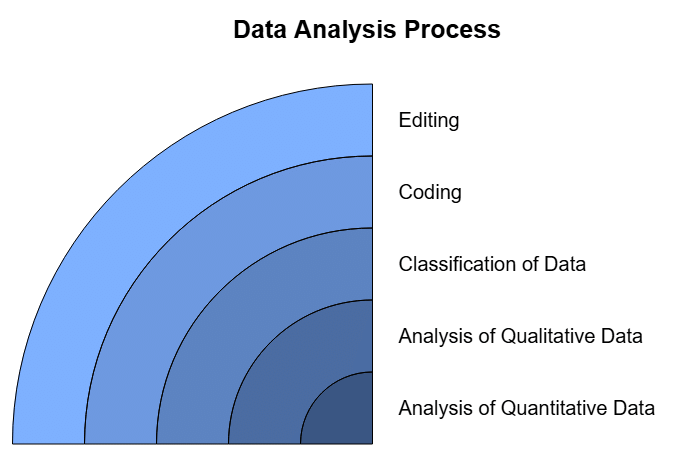
Analysis and Interpretation of Data
In this stage, the researcher analyzes the collected data to uncover common patterns within the responses and critically evaluates them to fulfill the research aims and objectives.Process of Analyzing Data:
Once the data is collected, the next step is to analyze it. This involves several closely related operations, including the establishment of categories for raw data through coding, tabulation, and drawing statistical inferences.
- Editing Editing is the process of cleaning data with the aim of identifying and minimizing errors, miscalculations, misclassifications, or any gaps in the information provided by respondents. The goal of editing is to enhance the quality of data for coding.
- Coding Coding involves determining the nature of the data, whether it is quantitative or qualitative. Qualitative data may be descriptive or categorical, such as gender, attitude (strongly favorable, favorable, unfavorable), or discrete categories.
Classification of Data
Classification of data involves arranging data into groups or classes based on common characteristics. Data can be classified in various ways:
Classification According to Attributes This classification can be descriptive or numerical, and it can be further divided into simple and manifold classifications:
(i) Simple Classification In simple classification, only one attribute is considered, and the universe is divided into two classes: one class consisting of items possessing the given attribute and the other class consisting of items that do not possess the given attribute.
(ii) Manifold Classification In manifold classification, two or more attributes are considered simultaneously, and the data is divided into several classes based on these attributes.
Classification According to Class Intervals This classification is used for quantitative data related to income, age, weight, production, occupancy, etc. Such data is classified based on class intervals.
Tabulation Tabulation is a technical procedure where classified data is presented in the form of tables. It involves summarizing raw data and displaying it in a compact form for further analysis. When dealing with large data sets, computers can be used for tabulation. It involves the orderly arrangement of data in columns and rows. Tabulation is essential because it:
- Conserves space and reduces explanatory and descriptive statements to a minimum.
- Facilitates comparison, summation of items, and detection of errors and omissions.
Data Analysis: Data analysis is performed using various mathematical and statistical techniques such as percentages, averages, correlation, regression, etc. The choice of analysis methods depends on whether the data is qualitative or quantitative.
Analysis of Qualitative Data
Qualitative data is non-numerical in nature and can be observed and recorded. This type of data is collected through methods such as observation and one-to-one interviews. There are no strict rules for analyzing qualitative data; it can be analyzed using deductive and inductive approaches:
- Deduc tive Approach: In this approach, qualitative data is analyzed based on a pre-determined structure set by the researcher.
- Inductive Approach In contrast, the inductive approach does not rely on a predetermined structure or set rules. It is used when the researcher has little or no prior knowledge of the research phenomenon. Qualitative data analysis is often interpretative in nature.
Analysis of Quantitative Data
Quantitative data is statistical and structured, meaning it is more rigid and defined. This type of data is measured using numbers and values. Various statistical analysis tools are used to identify statistical relationships between variables in quantitative data. Data analysis can be done manually or using a computer:
(i) Manual Data Analysis Manual data analysis is feasible when the number of respondents is relatively small and there are not many variables to analyze. It is useful for calculating frequencies and performing simple cross-tabulation.
(ii) Data Analysis Using Computer If a researcher wants to analyze data using a computer, they should be familiar with appropriate computer programs. The most commonly used software for data analysis is SPSS. In the analysis process, relationships or differences that support or contradict original or new hypotheses should be subjected to tests of significance.
Concluding the Data and Formal Write-up of the Research Report
- This step marks the final phase of the research process. Based on the interpretation of the data, certain generalizations may emerge. It is crucial that these generalizations are not influenced by personal opinions but are derived from a thorough analysis of the data.
- The credibility of the research outcomes hinges on the accuracy with which the findings from the data are reflected in the conclusions drawn.
Format of Report:
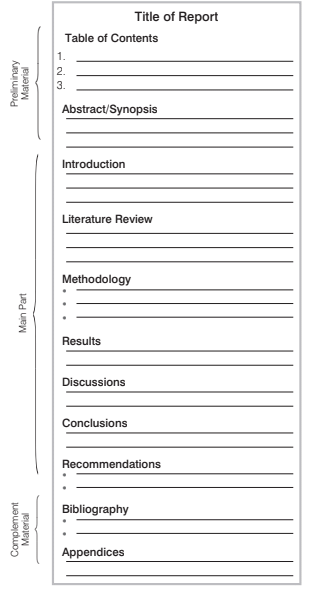
|
17 videos|30 docs|9 tests
|
FAQs on Research Problem - Research Aptitude Notes
| 1. What are the key steps to identify a research problem? |  |
| 2. How do I develop a hypothesis for my research? |  |
| 3. What is the importance of a well-defined research problem? |  |
| 4. What are common sources for identifying research problems? |  |
| 5. How can I ensure my research problem is relevant and significant? |  |





















